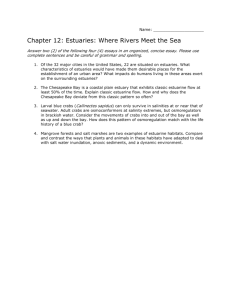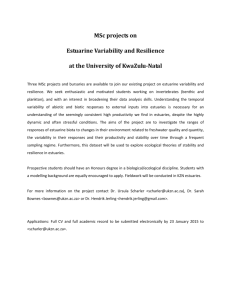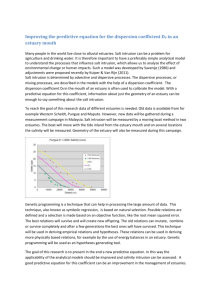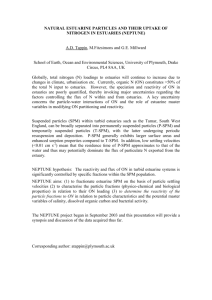Estuarine Dynamics.
advertisement
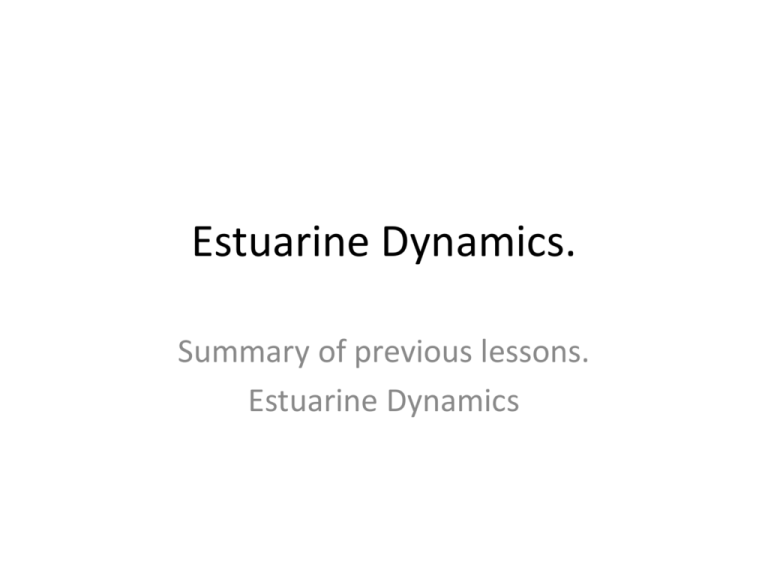
Estuarine Dynamics. Summary of previous lessons. Estuarine Dynamics Equations format for Env. Modelling Isolated System: dck ( Sok Sik ) dt Material System Moving with the flow: dck dt x j c ( Sok Sik ) x j Fixed region Space: ck u j ck t x j x j c ( Sok Sik ) x j Conservation Principle • Whatever is the form of the equation it always states: AccumulatioRate inFlow outFlow Sources Sinks • That can be reworded as: “The rate of accumulation is the symmetric of the divergence plus sources- sinks” ck t x j u j ck c x j ( Sok Sik ) Or, • Using the Divergence Theorem: dV v .n A n dA ( So Si ) t CV surface • All these forms of the equations are equivalent. We knew it from maths and from physics. Source and Sink terms. The Phyto Eq. dP p rp e p m p P GZ 2 .Z1 dt Lotka Volterra http://home.comcast.net/~sharov/PopEcol/ http://home.comcast.net/~sharov/PopEcol/lec10/lotka.html This model describes the dynamics, but it is quantitatively incorrect. Results: no interannual variability Why to study an estuary in the course? • Estuaries are among the richest ecosystems, • Estuarine ecosystems require knowledge of a large number of disciplines, • They are a good example to introduce a general approach that can be simplified in particular ecosystems. Estuaries vs Coastal Lagoons Fine (organic rich sediments settle in the upper estuary due to flocculation induced by salinity Estuary Definition • http://en.wikipedia.org/wiki/Estuary – An estuary is a partly enclosed coastal body of water with one or more rivers or streams flowing into it, and with a free connection to the open sea.[1] • In the Water Framework Directive: – An estuary is a “Transition Water” ) from a fresh water body into a coastal water body. Estuarine Life Estuaries are home to an astonishing variety of plants and animals and important in the lifecycles of many more. Salt Marshes importance Salt marshes form in shallow, quiet water, where the water is salty and still enough for the suspended particles to settle to the bottom. These marshes are some of the most productive lands in the world and produce so many organic nutrients that their influence can be seen far out into the coastal ocean waters. Marshes are based on one plant, the Saltmarsh Cordgrass, which helps stabilize the environment so that many other plants and animals to move in. Why are Estuaries so much demanded by people? • Because they generate opportunities: – – – – Goods, Navigation, Recreation, …….. • The estuarine ecosystem is biologically rich because estuaries are rich in nutrients/primary producers. They provide food and protection to many species of juveniles (they are nursery zones). • What about eutrophication? Classification of Estuaries • http://www.onr.navy.mil/focus/ocean/habitats/ estuaries1.htm • Coastal Plain Estuaries or Drowned river valleys, • Tectonic Estuaries, • Bar-built Estuaries or Lagoon type, • Fjords. Coastal Plain Estuaries 1. Coastal Plain Estuaries are formed by the sea level rising and filling an existing river valley. Examples of this are the Chesapeake Bay in Maryland and the harbor in Charleston, South Carolina Tectonic Estuaries 2. Tectonic Estuaries are caused by the folding or faulting of land surfaces. These estuaries are found along major fault lines, like the San Francisco Bay area in California. Bar-built Estuaries (Rias/Lagoas em Português) Bar-built Estuaries form when a shallow lagoon or bay is protected from the ocean by a sand bar or barrier island. Examples of these are found along the Eastern Seaboard and the Gulf Coast of North America. Fjords Fjords are U-shaped valleys formed by glacial action. Fjords are found in areas with long histories of glacier activity, like northern Europe, Alaska and Canada. Are this the only types of estuaries? • Most of today's estuaries formed because the sea level has slowly risen during the last 18,000 years, drowning river valleys and filling in glacial troughs. • This classification is relevant yes because it helps us describing estuaries. It is not because many estuaries do not fit in any of these types…. Continuação da Aula Anterior Estuarine Hydrodynamics: Tides • http://www.onr.navy.mil/focus/ocean/motion /tides1.htm • Tides are the periodic rise and fall of the ocean waters. They are caused by the gravitational pulls of the Moon and (to a lesser extent) Sun, as well as the rotation of the Earth. Classification based on water circulation http://en.wikipedia.org/wiki/Estuary Salt wedge In this type of estuary, river output greatly exceeds marine input and tidal effects have a minor importance. Fresh water floats on top of the seawater in a layer that gradually thins as it moves seaward. The denser seawater moves landward along the bottom of the estuary, forming a wedge-shaped layer that is thinner as it approaches land. As a velocity difference develops between the two layers, shear forces generate internal waves at the interface, mixing the seawater upward with the freshwater. An example of a salt wedge estuary is the Mississippi River.[5] Partially mixed estuary As tidal forcing increases, river output becomes less than the marine input. Here, current induced turbulence causes mixing of the whole water column such that salinity varies more longitudinally rather than vertically, leading to a moderately stratified condition. Examples include the Chesapeake Bay and Narragansett Bay.[5] Vertically homogenous Tidal mixing forces exceed river output, resulting in a well mixed water column and the disappearance of the vertical salinity gradient. The freshwater-seawater boundary is eliminated due to the intense turbulent mixing and eddy effects. The lower reaches of the Delaware Bay and the Raritan River in New Jersey are examples of vertically homogenous estuaries.[5] Fjord Inverse estuary Inverse estuaries occur in dry climates where evaporation greatly exceeds the inflow of fresh water. A salinity maximum zone is formed, and both riverine and oceanic water flow close to the surface towards this zone.[6] This water is pushed downward and spreads along the bottom in both the seaward and landward direction.[3] An example of an inverse estuary is Spencer Gulf, South Australia Intermittent Estuary Estuary type varies dramatically depending on freshwater input, and is capable of changing from a wholly marine embayment to any of the other estuary types.[7][8] (See also Estuarine water circulation) Estuarine hydrodynamics • Shallow water equations: • Hydrostatic pressure, • Vertical velocity is much smaller than horizontal velocity (coriolis), • Boussinesq approximation (density) Shallow Water Equations Pressure forces Free surface elevation Hydrostatic pressure: Pressure force MOHID Bathymetry Module • Bathymetry – Defines the horizontal grid – The grid can be uniform or variable – The number of grid points is typically 200x200 Vertical grid • Sigma coordinate • Cartesian coordinate MOHID main Modules • Hydrodynamic – Propriedades de escoamento (niveís, velocidades, fluxos) • Waterproperties (Eulerian, ) – Propriedades de águas (temperaturua, salinidade, phytoplankton, etc) – Abordagem euleriana • Lagrangian – Propriedades de águas (temperaturua, salinidade, phytoplankton, etc) – Abordagem lagrangiana • WaterQuality (Sources – Sinks) – Processos de qualidade de água (fontes e poços) – Funciona como um modelo 0D Mohid – Input Data File • Ficheiros ASCII • Palavras Chaves • Organização por blocos Mohid – Results (Time Series) • Séries temporais – Escrevem resultados pontuais com intervalos de tempos pequenos – São analisados no Excel • Para escrever – – – – – – – <BeginTimeSerie> LOCALIZATION_I : 44 LOCALIZATION_J : 27 LOCALIZATION_K :1 <EndTimeSerie> DT_OUTPUT_TIME : 3600. TIME_SERIE :1 Mohid – Results (HDF) • HDF – Escrevem resultados de todo o dominio com intervalos de tempos maiores – São analisados com a interface Gráfica • Para escrever – OUTPUT_TIME : 0. 3600. Mixed coordinate system Boundary Conditions • Open boundary • Closed boundary • Moving boundary The 2D model • Is equivalent to a 3D model using just one layer and sigma coordinate!

